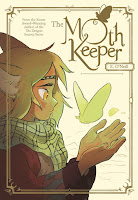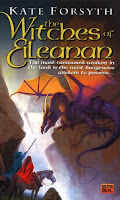Kate Wheeler is a familiar artist – I’ve been following her adventures on Instagram for years. So I was very excited to see her publicize her debut middle grade fantasy graphic novel. One of my favorite genres, from an author I know I like? Bless. I read it right away and loved it. Goat Magic is out today from Oni Press!
Trill, a spirited goat herder with a unique ability to communicate with her flock, yearns for a life beyond mountain pastures. Her “goat magic” feels common compared to the sorcery taught in the city’s prestigious magic schools, which are off-limits to her. Meanwhile, Princess Alya, known as the “Ordinary Princess” and heir to the kingdom of Capeya, doubts her own royal potential.Their worlds collide when an assassination attempt on the queen leaves Alya cursed to transform into a black goat each sunrise. Seeking refuge in Trill's goat herd, Alya discovers her new friend's hidden talent is her only hope to break the spell. Together, they embark on a perilous journey back to the castle, facing treacherous foes and uncovering a web of betrayal and rebellion.
As Alya battles to reclaim her throne and restore order to Capeya, the girls discover a deep connection, their shared experiences forging an unbreakable bond. When Alya comes face to face with the ones who betrayed her, will she have what it takes to take back the crown and rule an unstable kingdom? Will Trill find confidence in her magic and the growing affection she has for her friend?
With fast-paced action, enchanting magic, and a budding romance, Goat Magic is a captivating graphic novel perfect for fans of fantasy adventure.
Goat Magic opens on the humble farm where Trill and her mother keep a herd of goats. They live out in the Faces, a remote, magical part of the country where the rock formations look like ancient gods have been frozen in rest. Trill is off to the market by herself for the first time – a bit (adult!) step. At the same time, there is unrest within the royal family, as the heir to the throne, Alya, doesn’t have any magical abilities, and hence has been dubbed “The Ordinary Princess.” On a diplomatic trip, Alya’s mother, the Queen of Capeya, is attacked, and Alya herself is cursed – she becomes a goat during daylight hours and reverts to human form by the light of the moon. You can probably imagine what happens next: Alya meets Trill, observes her unique goat-herding magic firsthand, and has lots of her beliefs challenged by the experience. In addition, first love is in the air…
Wheeler says in the afterward and on social media that she was inspired by classic fantasy adventures from her childhood reading. It shows – mostly in good ways. The plot is a bit formulaic (think the hero’s journey), but the magic and world building feel refreshingly unique. Wheeler also includes very satisfying details about food, myths, and familial relationships – the things that round out and flesh out any culture or story and make them more believable. And lest I forget to mention them, the adorable goat characters also each have their own personalities and foibles.
The vibe of the book overall is The Witcher-meets-Studio Ghibli, and I know it will be a huge hit with the 9-12-year-old set as well as an older crowd. Wheeler’s art and “style” remind me quite a bit of the excellent Kay O’Neill (The Tea Dragon Society and The Moth Keeper) and Wendy Xu (Tidesong) – with good use of color, lovely landscapes, and expressive character faces.
In all, Goat Magic is a fantasy mystery wrapped in an adventure. It has notes of The Well (journey to remove a mysterious curse, budding sapphic romance) and classic fairy tale The Goose Girl (transformation tale). It's a quick, satisfying adventure into a novel world. I would love to read more adventures set in Capeya, or whatever Wheeler has up next!
Recommended for: fantasy readers ages 9 and up, and anyone interested in fantastic worldbuilding and fun and energetic graphic novel art!
Fine print: I received an advanced digital copy of the text from the publisher for review consideration. I did not receive any compensation for this post.

































